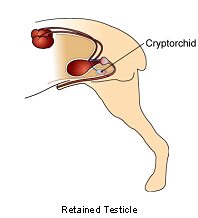Known Health Concerns in the Alaskan Klee Kai
While it’s true that the Alaskan Klee Kai aren’t typically associated with a long list of health conditions per se, it’s important to remember that some issues simply may not have yet been discovered due to the relative young age of the breed―they were only developed in the 1970’s after all! It’s just not possible for us to compare their health history to say, that of a golden retriever’s as the latter has been around for over 200 years!
Having said that however, there does appear to be a small number of health conditions that are seemingly linked to the Alaskan Klee Kai―while the following may not be a comprehensive list (for that, we’d have to collect much more data over many years), it does offer a helpful insight on their general health.
Thyroid Disease

As a result, the glands are progressively destroyed, a condition which may lead to chronic inflammation of the thyroid. Due to the hormone-secreting nature of the glands, autoimmune thyroiditis commonly causes classical signs of hypothyroidism (aka- a lack of thyroid hormone in the body).
Factor VII Deficiency
Factor VII deficiency is an inherited blood-clotting disorder which can lead to excessive bleeding. If an Alaskan Klee Kai has the condition, their bodies are unable to make sufficient amounts of Factor VII―a protein which acts as an essential element to the body’s blood coagulation system. This means that the affected dog has a higher chance of bleeding inordinately following an injury or even surgery.
Due to the fact that FVII Deficiency is an autosomal recessive trait (aka- two copies of the defective gene are needed for the condition), many Alaskan Klee Kai may actually be “carriers” of the disease rather than being affected themselves. For this reason, ethical breeders are extremely diligent at testing for the FVII mutation prior to breeding their dogs.
Cardiac Defects
Albeit rare, cardiac defects such as heart murmurs have been found in the breed. Considering this, all Alaskan Klee Kai are highly recommended to undergo screening as a puppy. However since it’s also a known fact that functional (aka- benign) heart murmurs are less common in mature dogs, evaluations should be obtained in adults who are over twelve months in age―especially those in a breeding program.
Cryptorchidism in Male Dogs

For reasons not entirely known, male Alaskan Klee Kai appear to be more prone to having retained testes; depending on how far they’ve descended, the testicles may or may not be palpable by hand. In the case that they cannot be felt from the outside, an ultrasound by a veterinarian may be necessary to determine its exact location.
Although Cryptorchidism is fairly common (particularly in smaller dogs), it does not pose any significant health risks or complications. Typically, a retained testicle is removed during a dog’s routine neutering―two separate incisions may be necessary if the two oval organs are located far from each other.
Patella Luxation
Patella Luxation is a common disorder in which a dog’s kneecap dislocates from its normal position at the end of the femur. Taking into account that it is a fairly prevalent issue in both Alaskan Eskimo and Schipperke dogs―two of the original breeds used for the development of the Alaskan Klee Kai, it’s imperative that all dogs be screened for the condition.
Although it is an inherited disease, Patella Luxation may not present immediately at birth; it is not uncommon for clinical signs of the anatomical deformities to only show itself once a puppy has begun to walk. While the degree of severity varies amongst affected dogs, it is not unusual for the problem to progressively worsen over time. Considering all of this, it is extremely important for all Alaskan Klee Kai to be evaluated for Patella Luxation by a veterinarian.

















